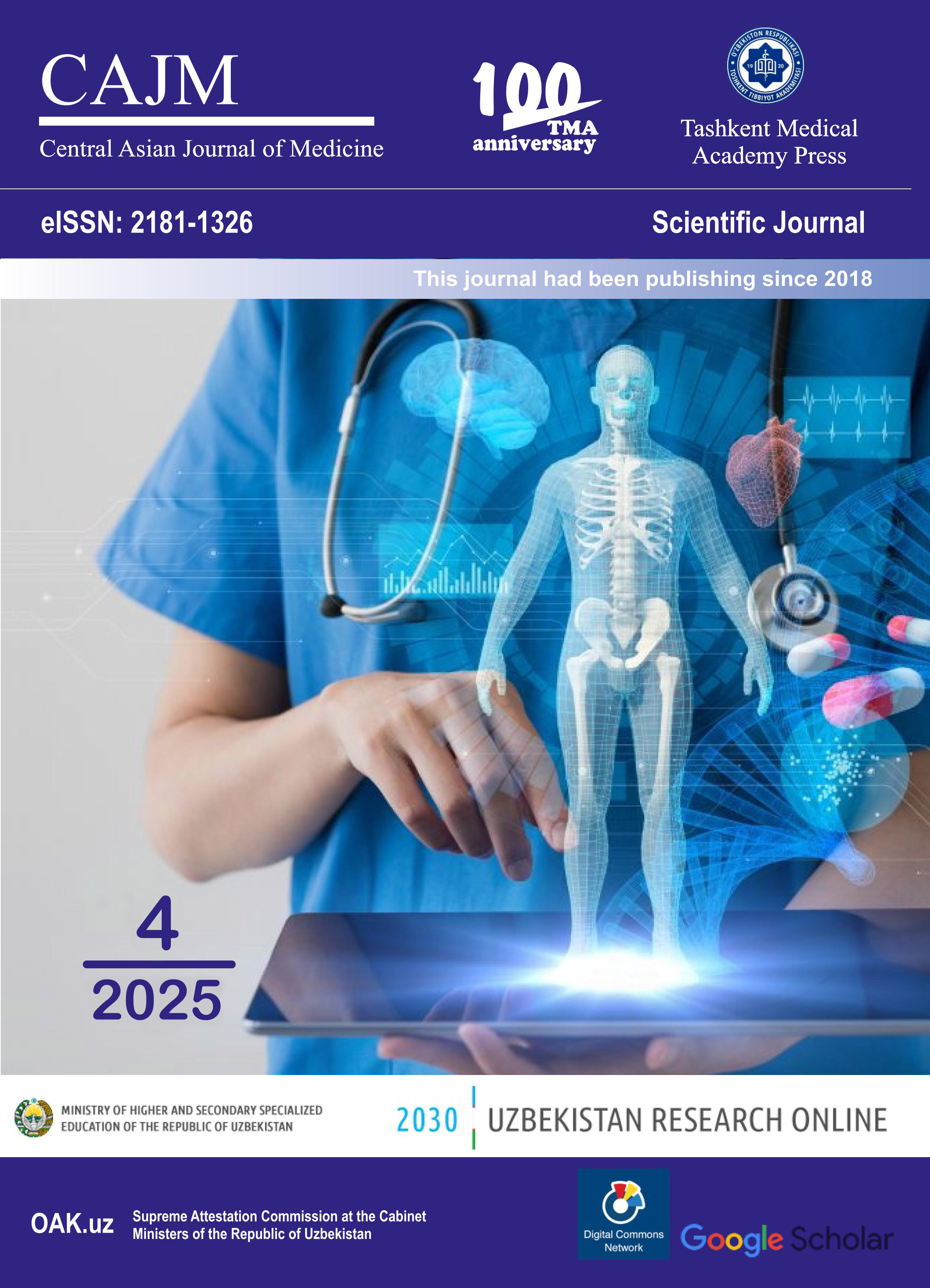MORPHOLOGICAL CHANGES IN THE PANCREAS OF OFFSPRING BORN FROM MOTHERS WITH EXPERIMENTAL DIABETES
Keywords:
maternal diabetes mellitus, offspring pancreatic development, pancreatic morphology, beta-cell mass, islet architecture.Abstract
Diabetes mellitus (DM) in the mother is a serious metabolic disorder that profoundly affects fetal development, in particular, the morphogenesis and functional maturation of the pancreas. This review summarizes the experimental data of studies investigating the morphological and functional state of the pancreas in the offspring of diabetic rat mothers. Using alloxan citrate buffered diabetic rat models, the researchers demonstrated that maternal hyperglycemia impairs pancreatic development, resulting in structural abnormalities such as reduced beta-cell mass, disorganized islet architecture, and impaired endocrine function in the offspring. Histopathological analyses reveal marked changes including reduced islet density, fibrosis, and irregular vascularization, which may contribute to long-term metabolic dysfunction, suggesting impaired adaptive mechanisms in glucose homeostasis. Mechanistically, these effects are attributed to intrauterine oxidative stress, epigenetic modifications, and altered expression of critical developmental genes. The results highlight the importance of glycemic control during pregnancy to mitigate the adverse effects of programming on pancreatic health in the offspring. Furthermore, this review highlights gaps in current research, such as the long-term consequences of these changes in adulthood and potential therapeutic interventions. Understanding these mechanisms may inform strategies to prevent metabolic disorders in individuals exposed to a diabetic intrauterine environment.
References
Aerts, L., & Van Assche, F. A. (1979). Is gestational diabetes an acquired condition? Journal of Developmental Physiology, 1(3), 219-225.
Aerts, L., & Van Assche, F. A. (2006). Animal evidence for the transgenerational development of diabetes mellitus. International Journal of Biochemistry & Cell Biology, 38(5-6), 894-903. https://doi.org/10.1016/j.biocel.2005.07.006
Apte, M. V., Pirola, R. C., & Wilson, J. S. (2019). Pancreatic stellate cells: A starring role in normal and diseased pancreas. Frontiers in Physiology, 10, 688. https://doi.org/10.3389/fphys.2019.00688
Blondeau, B., Garofano, A., Czernichow, P., & Breant, B. (2001). Age-dependent inability of the endocrine pancreas to adapt to pregnancy: A long-term consequence of perinatal malnutrition in the rat. Endocrinology, 142(10), 4208-4216. https://doi.org/10.1210/endo.142.10.8437
Brissova, M., Haliyur, R., Saunders, D., Shrestha, S., Dai, C., Blodgett, D. M., et al. (2018). alpha Cell function and gene expression are compromised in type 1 diabetes. Cell Reports, 22(10), 2667-2676. https://doi.org/10.1016/j.celrep.2018.02.032
El Hajj, N., Pliushch, G., Schneider, E., Dittrich, M., Muller, T., Korenkov, M., et al. (2017). Metabolic programming of MEST DNA methylation by intrauterine exposure to gestational diabetes mellitus. Diabetes, 66(4), 1020-1030. https://doi.org/10.2337/db16-0284
Eriksson, U. J., Cederberg, J., & Wentzel, P. (2003). Congenital malformations in offspring of diabetic mothers-Animal and human studies. Reviews in Endocrine and Metabolic Disorders, 4(1), 79-93. https://doi.org/10.1023/A:1021879504372
Gao, T., McKenna, B., Li, C., Reichert, M., Nguyen, J., Singh, T., et al. (2014). Pdx1 maintains beta cell identity and function by repressing an alpha cell program. Cell Metabolism, 19(2), 259-271. https://doi.org/10.1016/j.cmet.2013.12.002
Gauguier, D., Bihoreau, M. T., Ktorza, A., Berthault, M. F., & Picon, L. (1991). Inheritance of diabetes mellitus as consequence of gestational hyperglycemia in rats. Diabetes, 40(10), 1265-1270. https://doi.org/10.2337/diab.40.10.1265
Pasek, R. C., & Gannon, M. (2013). Advancements and challenges in generating accurate animal models of gestational diabetes mellitus. American Journal of Physiology-Endocrinology and Metabolism, 305(11), E1327-E1338. https://doi.org/10.1152/ajpendo.00425.2013
Petry, C. J., Santos, D. C., Luz, H., Oliveira, C. S., de Mello, D. G., & Driscoll, D. (2020). Impact of maternal diabetes on epigenetic modifications leading to diseases in offspring. Experimental Diabetes Research, 2020, 1-12. https://doi.org/10.1155/2020/8812634
Pinney, S. E., & Simmons, R. A. (2011). Epigenetic mechanisms in the pathogenesis of type 2 diabetes mellitus. Trends in Endocrinology & Metabolism, 21(4), 223-229. https://doi.org/10.1016/j.tem.2010.10.002
Plagemann, A., Harder, T., Brunn, M., Harder, A., Roepke, K., Wittrock-Staar, M., et al. (2010). Hypothalamic proopiomelanocortin promoter methylation becomes altered by early overfeeding: An epigenetic model of obesity and the metabolic syndrome. Journal of Physiology, 587(20), 4963-4976. https://doi.org/10.1113/jphysiol.2009.176156
Srinivasan, M., Katewa, S. D., Palaniyappan, A., Pandya, J. D., & Patel, M. S. (2008). Maternal high-fat diet consumption results in fetal malprogramming predisposing to the onset of metabolic syndrome-like phenotype in adulthood. American Journal of Physiology-Endocrinology and Metabolism, 291(4), E792-E799. https://doi.org/10.1152/ajpendo.00078.2006
Thompson, R. F., Fazzari, M. J., Niu, H., Barzilai, N., Simmons, R. A., & Greally, J. M. (2017). Experimental intrauterine growth restriction induces alterations in DNA methylation and gene expression in pancreatic islets of rats. Journal of Biological Chemistry, 282(13), 12011-12018. https://doi.org/10.1074/jbc.M700703200
Wu, Y., Lau, W. B., Lau, B., Li, Y., Ma, X., Yuan, Y., et al. (2018). A mechanistic study of toxic effects of high glucose and oxidative stress on glutamate transporter-1 in hippocampal neurons. Oxidative Medicine and Cellular Longevity, 2018, 1-12. https://doi.org/10.1155/2018/4511027
Zambrano, E., Martinez-Samayoa, P. M., Rodriguez-Gonzalez, G. L., & Nathanielsz, P. W. (2016). Dietary intervention prior to pregnancy reverses metabolic programming in male offspring of obese rats. Journal of Physiology, 588(10), 1791-1799. https://doi.org/10.1113/jphysiol.2010.190033

